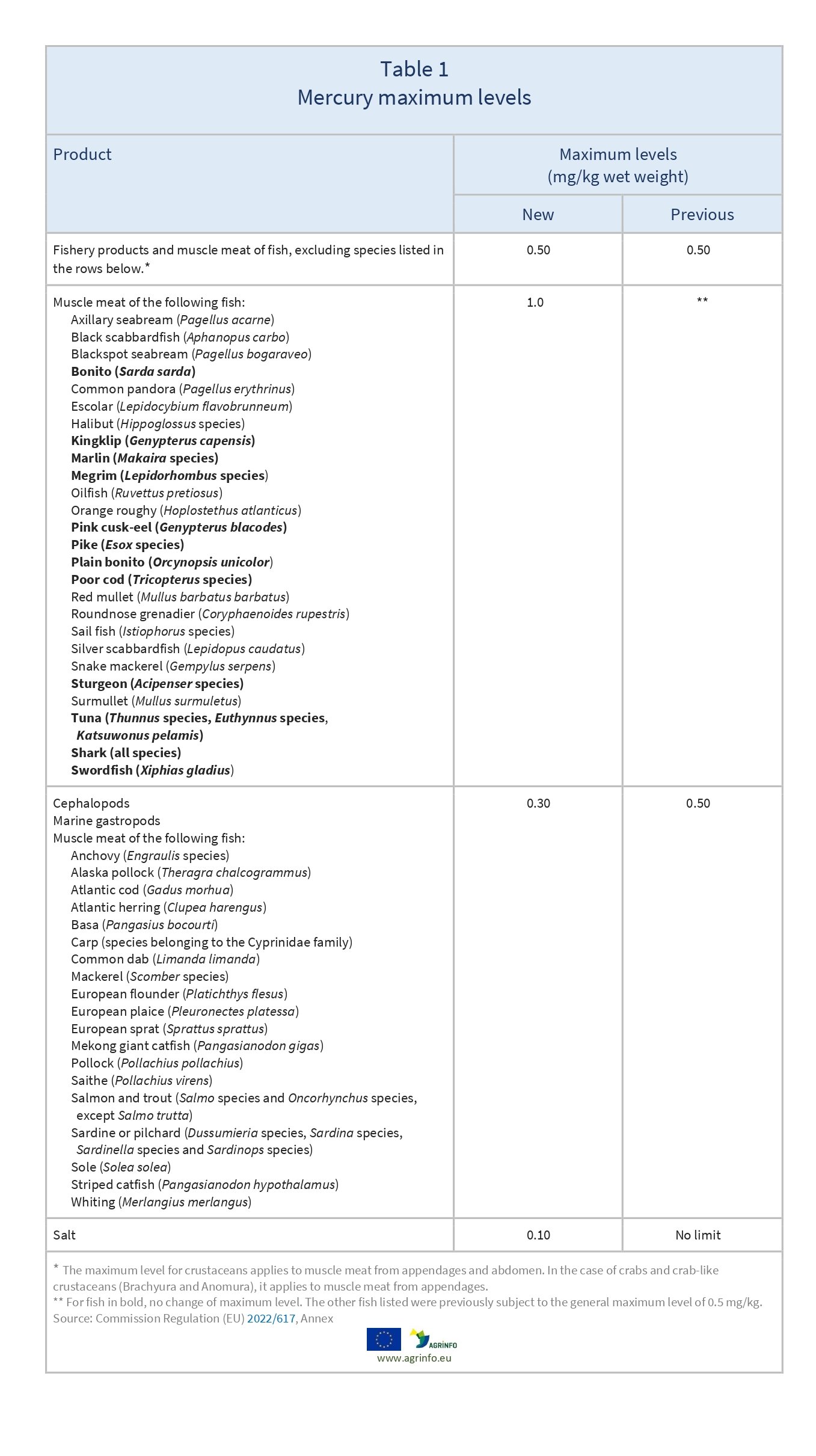Mercury maximum levels
- Contaminants
Summary
The EU has published Commission Regulation 2022/617 setting out maximum levels of mercury in fish and salt. It lowers the maximum level from 0.5 to 0.3 mg/kg for many fish species frequently consumed in the EU, and introduces a maximum level for salt.
New Regulation reduces maximum levels of mercury for several frequently consumed fish species and sets maximum level for salt
Commission Regulation (EC) 2022/617 of 12 April 2022 amending Regulation (EC) No 1881/2006 as regards maximum levels of mercury in fish and salt
Update
The EU has published Commission Regulation 2022/617 setting out maximum levels of mercury in fish and salt. It lowers the maximum level from 0.5 to 0.3 mg/kg for many fish species frequently consumed in the EU, and introduces a maximum level for salt.
Impacted Products
live fish, fresh/chilled fish, frozen fish, cephalopods, marine gastropods, salt
What is changing?
The EU is reducing maximum levels of mercury for several fish species, taking into account a margin to lower the maximum levels for mercury in these species. It is increasing the maximum allowed levels for several other species/groups, taking into account the beneficial effects of fish consumption. See Table 1 for details.
The maximum levels for valuable export commodities such as marlin, shark, swordfish and tuna are being maintained at the current level of 1.0 mg/kg wet weight pending further scientific assessment and knowledge on the effectiveness of consumption advice in reducing the exposure.
The EU has set a maximum level of 0.1 mg/kg for mercury in salt, in line with the Codex Alimentarius.
This Regulation amends Regulation (EC) 1881/2006 (subsequently replaced by Regulation (EU) 2023/915).
Why?
Maximum concentrations of mercury in fish, seafood and their products regularly exceed levels allowed by the European Commission. To protect particularly against the neurodevelopmental toxicity of methylmercury, the consumption of fish and seafood species with a high content of mercury should be limited.
Timeline
Published 13 April 2022
Entry into force 3 May 2022
What are the major implications for exporting countries?
This Regulation has potential implications for some of the fish and seafood species most widely imported into the EU. The maximum levels for valuable export commodities such as marlin, shark, swordfish and tuna for the time being are maintained at the current level of 1.0 mg/kg wet weight. These species often high mercury content, therefore third countries exporting these commodities to the EU should anticipate future regulatory change potentially affecting these species.
Recommended Actions
Exporters of halibut, marlin, shark, swordfish and tuna should urgently initiate a review of existing levels of mercury in these products.
In cases of levels exceeding the EU’s limits, further initiatives must be undertaken to identify and reduce exposure.
Information on recommended methods of sampling and analysis of mercury in foodstuffs can be found in Commission Regulation 333/2007.
Background
In 2012, the EFSA identified potential dietary exposure among EU citizens to mercury and methylmercury in food at levels that exceeded established the tolerable weekly intake (TWI) for inorganic mercury (4 µg/kg) and methylmercury (1.3 µg/kg). Mercury is an environmental contaminant that is present in fish and seafood products largely as methylmercury.
People who frequently consume large predatory fish, such as swordfish, tuna and halibut, may have a considerably higher intake of methylmercury and exceed the TWI. Methylmercury is highly toxic, particularly to the nervous system. The developing brain is thought to be the most sensitive target organ for methylmercury toxicity. Consumers of large amounts of fish would be particularly vulnerable. Consumers with high intake (95th percentile) would exceed the TWI in all age groups.
Regulation 2022/617 also increases the maximum allowed levels for several species/groups, and decreases the levels for others. The maximum levels for those fish species are modified taking into account the beneficial effects of fish consumption. In addition, Codex Alimentarius has established the maximum levels for mercury in salt that can be appropriately introduced into EU legislation.
Resources
EFSA (2012) Scientific Opinion on the risk for public health related to the presence of mercury and methylmercury in food. EFSA Journal, 10(12): 2985.
EFSA (2014) Scientific Opinion on health benefits of seafood (fish and shellfish) consumption in relation to health risks associated with exposure to methylmercury. EFSA Journal, 12(7): 3761.
EFSA (2015) Statement on the benefits of fish/seafood consumption compared to the risks of methylmercury in fish/seafood. EFSA Journal, 13(1): 3982.
Sources
Tables & Figures

.
Disclaimer: Under no circumstances shall COLEAD be liable for any loss, damage, liability or expense incurred or suffered that is claimed to have resulted from the use of information available on this website or any link to external sites. The use of the website is at the user’s sole risk and responsibility. This information platform was created and maintained with the financial support of the European Union. Its contents do not, however, reflect the views of the European Union.
